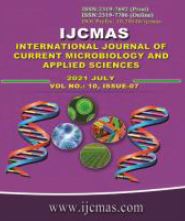


 National Academy of Agricultural Sciences (NAAS)
National Academy of Agricultural Sciences (NAAS)

|
PRINT ISSN : 2319-7692
Online ISSN : 2319-7706 Issues : 12 per year Publisher : Excellent Publishers Email : editorijcmas@gmail.com / submit@ijcmas.com Editor-in-chief: Dr.M.Prakash Index Copernicus ICV 2018: 95.39 NAAS RATING 2020: 5.38 |
During the pandemic, the combination of covid 19 with systemic steroids has caused a dramatic increase in the Mucormycosis cases in India. Our narrative review aims to understand the possible pathomechanisms involved in this exponential increase of Mucormycosis cases. The pathogen's virulence depends on the organism's ability to survive in the host by evading the immune system and causing harm to the host cells. Factors involved in the pathogenesis of COVID 19 which might be interested in the pathomechanisms of Mucormycosis are (1) increased expression of GRP 78 receptors (2) alteration of iron metabolism – the role of ferritin and iron (3) hepcidin mimicking activity (4) endothelities (5) damage to beta islet cells of pancreas (6) use of corticosteroid. Heath care-related or nosocomial infection though rare, can not be neglected. Mucormycosis developed in patients with both active SAR-CoV infection and patients who had recovered from COVID19 illness. Mucormycosis involving the nose and sinuses was the most common type. Early diagnosis and treatment of Mucormycosis are essential, as it improves the outcome and decreases the need for surgical intervention hence disfigurement. The combination of COVID 19 infection, steroid use, diabetes, and hospitalisation has caused a surge in Mucormycosis cases in COVID 19 infected patients. Further understanding of the pathogenesis helps in taking measures in the prevention and early management of the infection.
 |
 |
 |
 |
 |